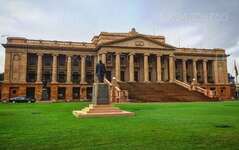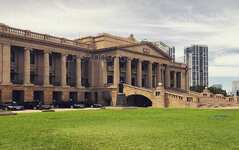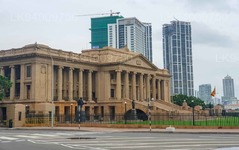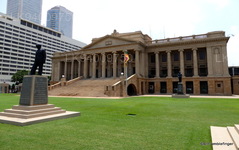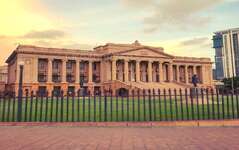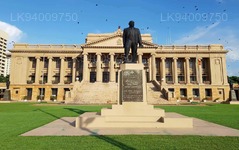
Colombo City
Colombo, the capital of Sri Lanka, is a dynamic city blending tradition and modernity. It showcases colonial architecture, lively markets, and serene Buddhist temples. With diverse cuisine, a growing skyline, and beautiful beaches, it's a vibrant hub for business, culture, and tourism, offering a gateway to explore Sri Lanka's wonders.
Old Parliament Building
Old Parliament Building in Sri Lanka: The Center of Administration
Travelling past Colombo’s Galle Face Green towards the area known as Fort, a cityscape looms. In the background, silvery skyscrapers and cream-colored buildings dominate. You will notice a building close to the sea whose dimensions are in complete contrast, being several hundred meters long and only three storey’s high.
This Neo-Baroque-style building was built during the British colonial era to house the Legislative Council of Ceylon. It was built on an idea of Sir Henry McCallum, which led to a proposal made by a committee to construct the new building for the Secretariat, Council Chamber and Government offices on reclaimed land at the northern end of Galle Face’ were accepted by the Government in 1920.
The chief architect of the Public Works Department, A. Woodson was responsible for the design of the building with his initial estimate of Rs 400,000 for the scheme being later revised Rs 450,000, taking into account the extra expenses involved.The building was declared open as the Legislative Council on January 29, 1930, by Governor Sir Herbert Stanley. He expressed the desire that “all the deliberations, which will be conducted within these walls may serve to weld the several communities and classes of the population together into an organic unity of national life and national progress, not by the suppression of varying traditions but by their co-ordination on a basis of mutual respect.”
Old Parliament Building in Sri Lanka: Architecture
The revivalist architecture of the Old Parliament Building in Sri Lanka integrated exquisite columns of the classical “Ionic” design, gently fluted towards the capital with a representation of two opposed scrolls. The façade of this magnificent building has an entrance reached by ascending many flights of broad steps. At the top are six columns supporting a traditional triangular pediment, and on either side are four more columns. Along the length of the structure is a series of colonnades, a pair with eleven columns each. The building has been aptly described by Sri Lankan architectural historian Ismeth Raheem as a “masterpiece in stone”.
Woodeson gave the building an open outlook so it would receive the maximum benefit from cool breezes. He was also wise enough to locate the Council Chamber on the east side of the building, away from the noise of the sea and sheltered from the afternoon sun. Incidentally, the initial estimate for the construction was 400,000 rupees, which was later revised by the Public Works Advisory Board to 450,000 rupees.
Great care was taken by Woodeson with the interior design, in particular the working environment. Cork carpet and linoleum were used to minimize noise. Lighting is indirect and secluded. Within the Chamber, the acoustic properties are as perfect as possible. Ventilation was provided by air propelled into the building by basement fans. Under members’ seats were adjustable grills through which the air flowed, thus eliminating the need for electric fans that so easily disturb public speaking. In addition, the
illumination of the upper portion of the Chamber is achieved by means of the reflection of floodlights fitted outside the topmost windows.
The British Coat of Arms adorned the top of the building face till 1948, when it was replaced by the arms of the Dominion of Ceylon and was once again replaced in 1972 with the arms of the Democratic Socialist Republic of Sri Lanka.
Since 1983 the Old Parliament, as mentioned earlier, has functioned as the Presidential Secretariat and the Office of the Executive President. This is where all important official announcements are made and appointments of state administered. The building, especially the former Council Chamber, is also the venue for various state functions. In addition, the letters of credence of arriving ambassadors and high commissioners are accepted here by former President Mahinda Rajapaksa.
The front garden of the Old Parliament Building is host to several bronze statues of eminent statesmen;
- Rt Hon D. S. Senanayake – First Prime Minister of Ceylon
- Hon Dudley Senanayake – Prime Minister of Ceylon
- General Sir John Kotalawela – Prime Minister of Ceylon
- Sir Ponnambalam Ramanathan KCMG, KC – Attorney General and first native elected member of a Legislative Council in the British Empire
Nowadays there is nothing other than passing traffic to diminish the view of the Indian Ocean from the west-facing frontage of the Old Parliament. But during those early years in the 1930s there was a former guardroom on the seafront that served as the headquarters of the Boy Scouts Association of Ceylon.
About Colombo District
Colombo is the largest city and commercial capital of Sri Lanka. It is located on the west coast of the island and adjacent to Sri Jayewardenepura Kotte, the capital city of Sri Lanka. Colombo is a busy and vibrant city with a mixture of modern life and colonial buildings and ruins and a city population of 647,100.The Colombo Metropolitan Region, defined by the districts of Colombo, Gampaha and Kalutara, has an estimated population of 5,648,000, and covers an area of 3,694.20 km²
Colombo is a multi-ethnic, multi-cultural city. It is the most populous city in Sri Lanka, with 642,163 people living within the city limits. The population of Colombo is a mix of numerous ethnic groups, mainly Sinhalese, Moors and Tamils. There are also small communities of people with Chinese, Portuguese, Dutch, Malay and Indian origins living in the city, as well as numerous European expatriates.
The great majority of Sri Lankan corporations have their head offices in Colombo. Some of the industries include chemicals, textiles, glass, cement, leather goods, furniture, and jewellery. In the city center is located South Asia's second tallest building - The World Trade Centre.
About Western Province
The Western Province is the most densely populated province of Sri Lanka. It is home to the legislative capital Sri Jayawardenepura Kotte as well to Colombo, the nation's administrative and business center. Western Province is divided into 3 main districts called Colombo (642 km²), Gampaha (1,386.6 km²) and Kalutara (1,606 km²) districts. As Sri Lanka's economic hub, all the major local and international corporations have their presence in the city and so do all the major designer and high street retailers, so be ready to indulge in some retail therapy in western province.
Having the highest population in the all the provinces, the almost all the premier educational institutions in the island are located in western province. Universities in the province include the University of Colombo, the University of Sri Jayewardenepura, University of Kelaniya, Open University, Sri Lanka, Buddhist and Pali University of Sri Lanka, General Sir John Kotelawala Defence University and University of Moratuwa .Western province has the largest amount of schools in the country, which includes National, Provincial, Private and International schools.

